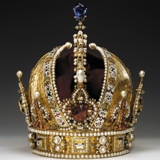Imperial Regalia
The Imperial Regalia, also sometimes referred to as insignia, are the only - almost completely - preserved crown jewels of the Middle Ages. The regalia is composed ot the Imperial Crown (Reichskrone), the coronation vestments (Krönungsornat), the Imperial Orb (Reichsapfel) and the Imperial Sceptre (Szepter), the Imperial and Ceremonial Swords (Reichs- und Zeremonienschwert), the Imperial Cross (Reichskreuz), the Holy Lance (Heilige Lanze) and other reliquaries, St. Stephen's Purse (Stephansbursa),the Imperial Bible (Reichsevangeliar) as well as the so-called Saber of Charlemagne ("Säbel Karls des Großen").
During the history of the Holy Roman Empire, all items of the regalia were of utmost importance and enjoyed great symbolic power, which was particularly important, when the legitimacy of the Emperor was questioned. It cannot be clearly defined which items from which moment belonged to the insignia. There is also uncertainties as to who and where they have been manufactured.
In the beginning the Imperial Regalia were not kept in a specific place, but accompanied the Emperor on his journeys through the Holy Roman Empire or were kept in safe places such as castles and fortresses. It was only as late as in 1423 that Emperor Sigismund decided that the Imperial Regalia should be given "eternally" to Nuremberg - except for St. Stephen's Purse (Stephansbursa), the Imperial Bible (Reichsevangeliar) and the Saber of Charlemagne (Säbel Karls des Großen), which were kept in Aachen (Aix la Chapelle). The regalia, sometimes referred to as "Nuremberg jewels", arrived there in 1424, where they stayed until the end of the 18th century, unless needed for a coronation ceremony.
In the aftermath of the French Revolution there was growing unrest and turbulences in Europa. As early as in 1794 the Aachen jewels (Aachener Kleinodien) were evacuated towards the West and when in 1796 French troops crossed the river, the Nuremberg regalia were brought to Regensburg and four years later - in 1800 - saved to Vienna, where they were reunited with the Aachen jewels after their interim stop in Hildesheim.
When in 1806 the Holy Roman Empire was dissolved by its last Emperor Franz II, the Imperial Regalia were still in Vienna. According to international law, the property of a person, who does not have a legal successor at the moment of its disintegration, is transferred to the State, where it is physically situated at the moment of the dissulution. therefore the Imperial Regalia lawfully belong to the Republic of Austria, which is the legal successor of the Austrian Empire, founded in 1804. This is how the proponents justify the display of the Imperial Regalia in Vienna.
The cities of Nuremberg and Aachen, however, interpreted the situation in a different way and asked for the return of the Imperial Regalia. At least Nuremberg was successful for a short period: in 1938 Adolf Hilter ordered that the Imperial Regalia were taken to Nuremberg, where they were displayed first in the Katharinenkirche and then in an air raid shelter. In 1945 US troops found the insignia and due to US intervention, the Imperial Regalia were returned to Vienna in 1946.
Since then the Imperial Regalia of the Holy Roman Empire have been one of the highlights of the Imperial Treasury Museum in the Hofburg Palace and have a particular attraction for its visitors. The editors of the website www.wiener-schatzkammer.at recommend to put a special focus on the Imperial Insignia and to plan at least 15 minutes for their visit only.
If you want to know more about the Imperial Regalia and their significance in the history of the Holy Roman Empire, you will get more detailed information during our fascinating guided tours of the Schatzkammer museum. We want to draw your special attention to the themed tours offered by our partners, the authors of history and arts publications from Wien Führungen!
